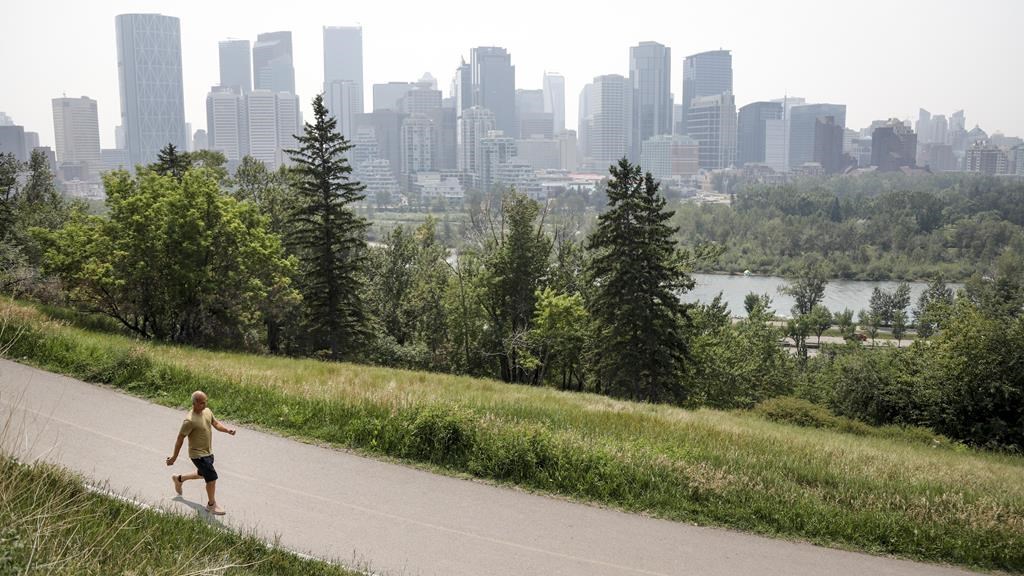The City of Calgary is giving away 2,000 trees to residential homes this year, but a city councillor is saying the program needs to be more equitable to the city’s northeast.

The city’s Branching Out program aims to increase Calgary’s tree canopy coverage by giving away trees to residents who want to help.
The city said Calgary’s average tree canopy coverage is currently at 8.25 per cent, and officials are working to expand that to 16 per cent.
Trees are provided at no cost by the city and will be equally distributed across all four quadrants of the city.
But Ward 5 Coun. Raj Dhaliwal says the northeast quadrant deserves more because it has the least tree coverage.
Ward 5 has the least tree coverage compared with all the other wards, he said. Saddleridge has the least tree canopy at around 1.27 per cent.

“I would love for the city to target Ward 5 and bring us to that benchmark of 8.4 per cent,” Dhaliwal told Global News.
“People are telling me that when they go to other parts of the city and they see so many trees there, especially towards the west of the city. It’s so different than what we see in Ward 5.”
Dhaliwal added that the lack of trees in the ward marks a very big socioeconomic difference compared with the other wards in the city.
Most of the trees are concentrated in areas with high-income households, and the lack of trees makes Ward 5 residents feel disadvantaged.

Get breaking National news
There needs to be a systemic change in how the City of Calgary designs and redevelops its communities, Dhaliwal said. City officials need to revisit the urban forestry management program and its parks programs, targeting areas where green space is lacking.

The city can also partner with community organizations and look into federal funding to plant trees in the city’s northeast.
“There’s a big perception in Ward 5 that (city planners) consciously ignore this part of the city. They see it as a form of environmental discrimination,” Dhaliwal said.
“You can’t put a tree anywhere. You have to come up with a plan, and the plans so far have lacked that vision and the space we’ve created haven’t allowed trees to succeed here.”
Urban forestry superintendent Mike Mahon said the Branching Out program will eventually allocate trees to communities that need them the most but that need to be data-driven and based on demand.
Mahon added that Ward 5 is in a grassland region and has poorer soil quality and lower levels of water compared with the west, which is closer to rivers and parkland.
“We have plans to increase biodiversity in grassland areas. We’re looking at naturalizing areas for parks and open spaces,” Mahon said.
“But we’re still looking to grow tree canopy and that doesn’t mean we’re not committed to planting trees in the northeast … it just requires a higher level of funding and resources.”

Emily Amon, green infrastructure manager at Green Communities Canada, said tree canopy is not only beneficial for the environment but also has mental health benefits.
Trees contribute to urban cooling and help reduce flooding while also providing access to green space. Communities that have access to trees have better social cohesion and mental health, Amon said.
However, areas that are economically poorer and socially marginalized traditionally have less tree cover, contributing to higher climate risks.
This is especially true for communities that have a majority of the city’s Black, Indigenous and people of colour (BIPOC).
“There is a term called environmental racism that relates to a lot of economic factors,” Amon told Global News.
“There is a perspective that communities, especially BIPOC communities, may not have the same level of empowerment or engagement with the city planning process.”

Amon said the city can try and solve the inequities by partnering with social housing corporations to prioritize tree planting on lots with subsidized housing.
The city can also prioritize expanding and improving green space in established parks in those areas, she said.
“The city can also take abandoned lots and remove the asphalt in the area and replant trees,” Amon said.
“Where there are derelict buildings and hard surfaces that are unused … those can be transformed into new parks and new green spaces.”
Residents with smaller lots that might not be able to accommodate a tree can consider planting community gardens or micro prairies.
Micro prairie plants — such as grass, coneflowers and milkweeds — attract native insects (bees, butterflies) and birds to look for natural food sources like nectar, pollen, seeds and berries.
Gardens can also help increase food security while also providing meaningful connections with nature, according to Amon.
“You can do what is called lasagna gardening, where you take some sheeting and cardboard and place it on top of turf grass and add soil then plant some vegetables and grains for the following year,” Amon said.








Comments